Diode-Pumped Single-Longitudinal-Mode Pr3+:YLF Laser Based on Combined Fabry–Perot Etalons at 522.67 nm
Abstract
:1. Introduction
2. Experimental Setup
3. Experimental Principle
4. Experimental Results and Discussion
5. Conclusions
Author Contributions
Funding
Institutional Review Board Statement
Informed Consent Statement
Data Availability Statement
Acknowledgments
Conflicts of Interest
References
- Pan, D.; Ke, C.; Fu, S.; Liu, Y.; Liu, D.; Willner, A.E. All-optical spectral linewidth reduction of lasers for coherent optical communication. Opt. Lett. 2013, 38, 5220–5223. [Google Scholar] [CrossRef] [PubMed]
- Wang, R.; Xia, Y.; Grosser, H.; Wetzel, H.U.; Kaufmann, H.; Zschau, J. The 2003 Bam (SE Iran) earthquake: Precise source parameters from satellite radar interferometry. Geophys. J. R. Astron. Soc. 2010, 159, 917–922. [Google Scholar] [CrossRef]
- Camacho-López, S.; Damzen, M.J. Self-starting Nd:YAG holographic laser oscillator with a thermal grating. Opt. Lett. 1999, 24, 753–755. [Google Scholar] [CrossRef] [PubMed]
- Liu, Z.; Cai, Z.; Huang, S.; Zeng, C.; Meng, Z.; Bu, Y.; Luo, Z.; Xu, B.; Xu, H.; Ye, C.; et al. Diode-pumped Pr3+:LiYF4 continuous-wave deep red laser at 698 nm. J. Opt. Soc. Am. B 2013, 30, 302–305. [Google Scholar] [CrossRef]
- Okhapkin, M.V.; Skvortsov, M.N.; Belkin, A.M.; Kvashnin, N.L.; Bagayev, S.N. Tunable single-frequency diode-pumped Nd:YAG ring laser at 1064/532nm for optical frequency standard applications. Opt. Commun. 2002, 203, 359–362. [Google Scholar] [CrossRef]
- Yang, F.; Ye, Q.; Pan, Z.; Chen, D.; Cai, H.; Qu, R.; Yang, Z.; Zhang, Q. 100-mW linear polarization single-frequency all-fiber seed laser for coherent Doppler lidar application. Opt. Commun. 2012, 285, 149–152. [Google Scholar] [CrossRef]
- Sotor, J.Z.; Antończak, A.J.; Abramski, K.M. Single-longitudinal mode Nd:YVO4/YVO4/KTP green solid state laser. Opto-Electron. Rev. 2010, 18, 75–79. [Google Scholar] [CrossRef]
- Sotor, J.Z.; Dudzik, G.; Antonczak, A.J.; Abramski, K.M. Single-longitudinal mode, monolithic, green solid-state laser. Appl. Phys. B 2011, 103, 67–74. [Google Scholar] [CrossRef]
- Esterowitz, L.; Bartoli, F.J.; Allen, R.E.; Wortman, D.E.; Morrison, C.A.; Leavitt, R.P. Energy levels and line intensities of Pr3+ in LiYF4. Phys. Rev. B 1979, 19, 6442–6455. [Google Scholar] [CrossRef]
- Richter, A.; Heumann, E.; Huber, G.; Ostroumov, V.; Seelert, W. Power scaling of semiconductor laser pumped Praseodymium-lasers. Opt. Express 2007, 15, 5172–5178. [Google Scholar] [CrossRef]
- Metz, P.W.; Reichert, F.; Moglia, F.; Müller, S.; Marzahl, D.T.; Kränkel, C.; Huber, G. High-power red, orange, and green Pr3+:LiYF4 lasers. Opt. Lett. 2014, 39, 3193–3196. [Google Scholar] [CrossRef] [PubMed]
- Sugiyama, N.; Fujita, S.; Hara, Y.; Tanaka, H.; Kannari, F. Diode-pumped 640 nm Pr:YLF regenerative laser pulse amplifier. Opt. Lett. 2019, 44, 3370. [Google Scholar] [CrossRef] [PubMed]
- Tanaka, H.; Fujita, S.; Kannari, F. High-power visibly emitting Pr3+:YLF laser end pumped by single-emitter or fiber-coupled GaN blue laser diodes. Appl. Opt. 2018, 57, 5923–5928. [Google Scholar] [CrossRef] [PubMed]
- Luo, S.; Cai, Z.; Xu, H.; Shen, Z.; Chen, H.; Li, L.; Cao, Y. Direct oscillation at 640-nm in single longitudinal mode with a diode-pumped Pr:YLF solid-state laser. Opt. Laser Technol. 2019, 116, 112–116. [Google Scholar] [CrossRef]
- Zhang, Y.; Zhou, L.; Zhang, T.; Cai, Y.; Xu, B.; Xu, X.; Xu, J. Blue diode-pumped single-longitudinal-mode Pr:YLF lasers in orange spectral region. Opt. Laser Technol. 2020, 130, 106373. [Google Scholar] [CrossRef]
- Mu, X.S.; Jin, L.; Dong, Y.; Yu, Y.J.; Jin, G.Y. Double-pulse narrow-linewidth Pr:YLF laser with acousto-optic Q-switching and double Fabry–Perot etalon technology. Opt. Commun. 2023, 527, 128924. [Google Scholar] [CrossRef]
- Lu, H.; Su, J.; Zheng, Y.; Peng, K. Physical conditions of single-longitudinal-mode operation for high-power all-solid-state lasers. Opt. Lett. 2014, 39, 1117–1120. [Google Scholar] [CrossRef]
- Dai, T.; Wu, J.; Zhang, Z.; Ju, Y.; Yao, B.; Wang, Y. Diode-end-pumped single-longitudinal-mode Er:LuAG laser with intracavity etalons at 1.6 μm. Appl. Opt. 2015, 54, 9500–9503. [Google Scholar] [CrossRef]
- Chen, S.Y.; Yang, H.L.; Wang, M.J.; Zhang, X.; Jiang, J.; Meng, J.Q.; Chen, W.B. Analysis of Natural Longitudinal Mode Selection in Passively Q-Switched Lasers. Chin. J. Lasers 2016, 43, 0801006. [Google Scholar] [CrossRef]
- Wu, E.; Pan, H.; Zhang, S.; Zeng, H. High power single-longitudinal-mode operation in a twisted-mode-cavity laser with a c-cut Nd:GdVO4 crystal. Appl. Phys. B 2005, 80, 459–462. [Google Scholar] [CrossRef]
- Svelto, O. Principles of Lasers; Springer: New York, NY, USA, 2010. [Google Scholar]
- Luo, S.; Yan, X.; Cui, Q.; Xu, B.; Xu, H.; Cai, Z. Power scaling of blue-diode-pumped Pr:YLF lasers at 523.0, 604.1, 606.9, 639.4, 697.8 and 720.9 nm. Opt. Commun. 2016, 380, 357–360. [Google Scholar] [CrossRef]
- Jin, L.; Dai, W.; Yu, Y.; Dong, Y.; Jin, G. Single longitudinal mode Q-switched operation of Pr:YLF laser with pre-lase and Fabry–Perot etalon technology. Opt. Laser Technol. 2020, 129, 106294. [Google Scholar] [CrossRef]



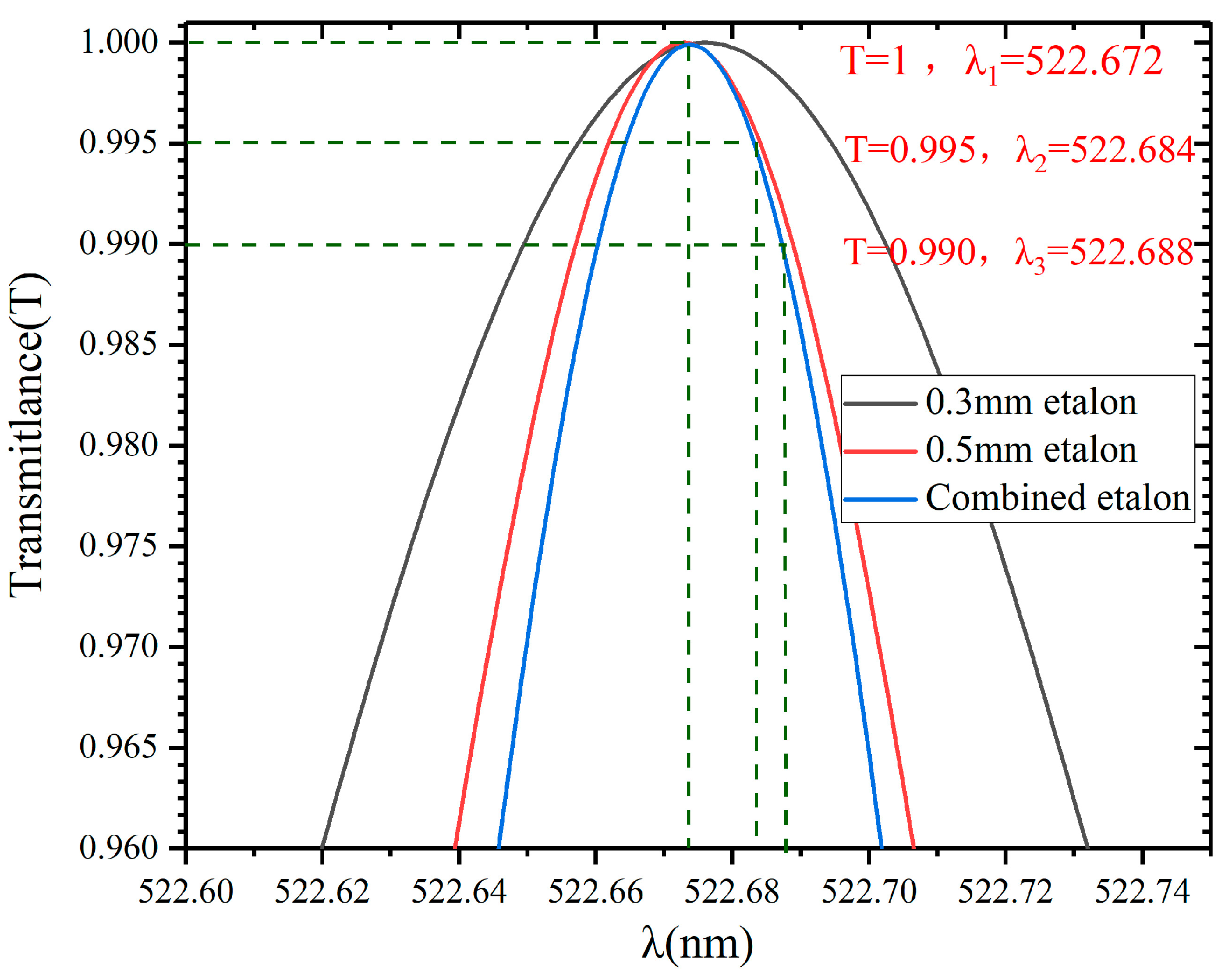


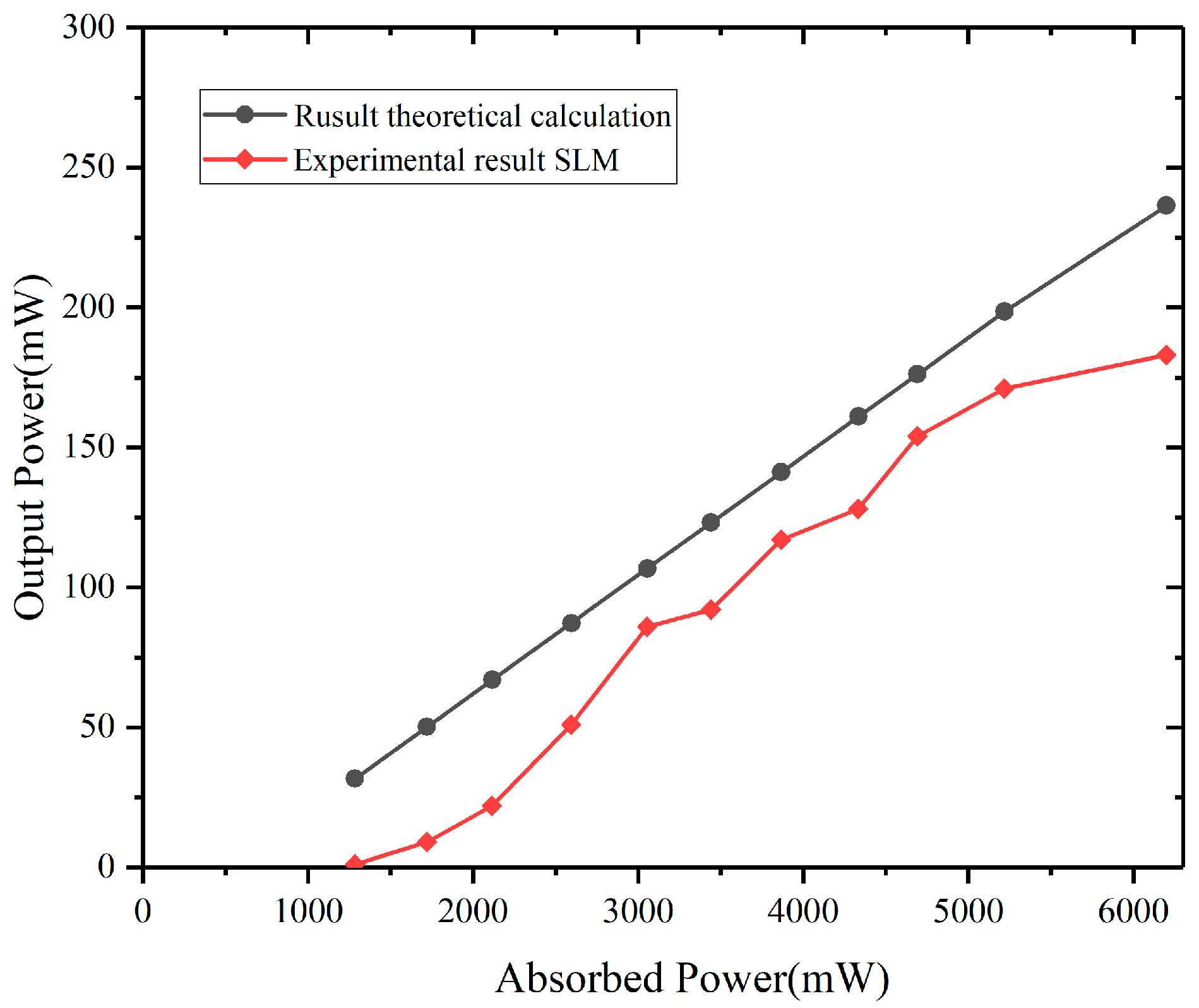
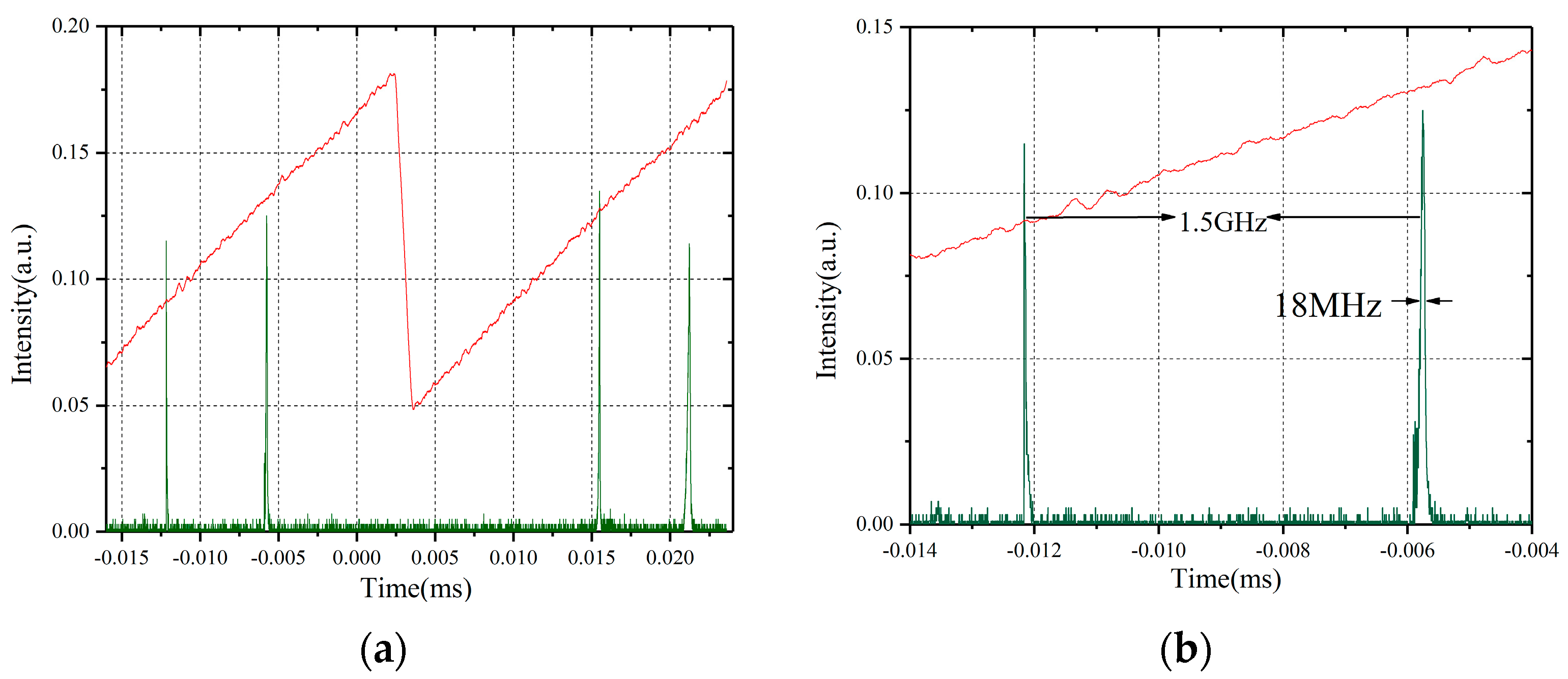
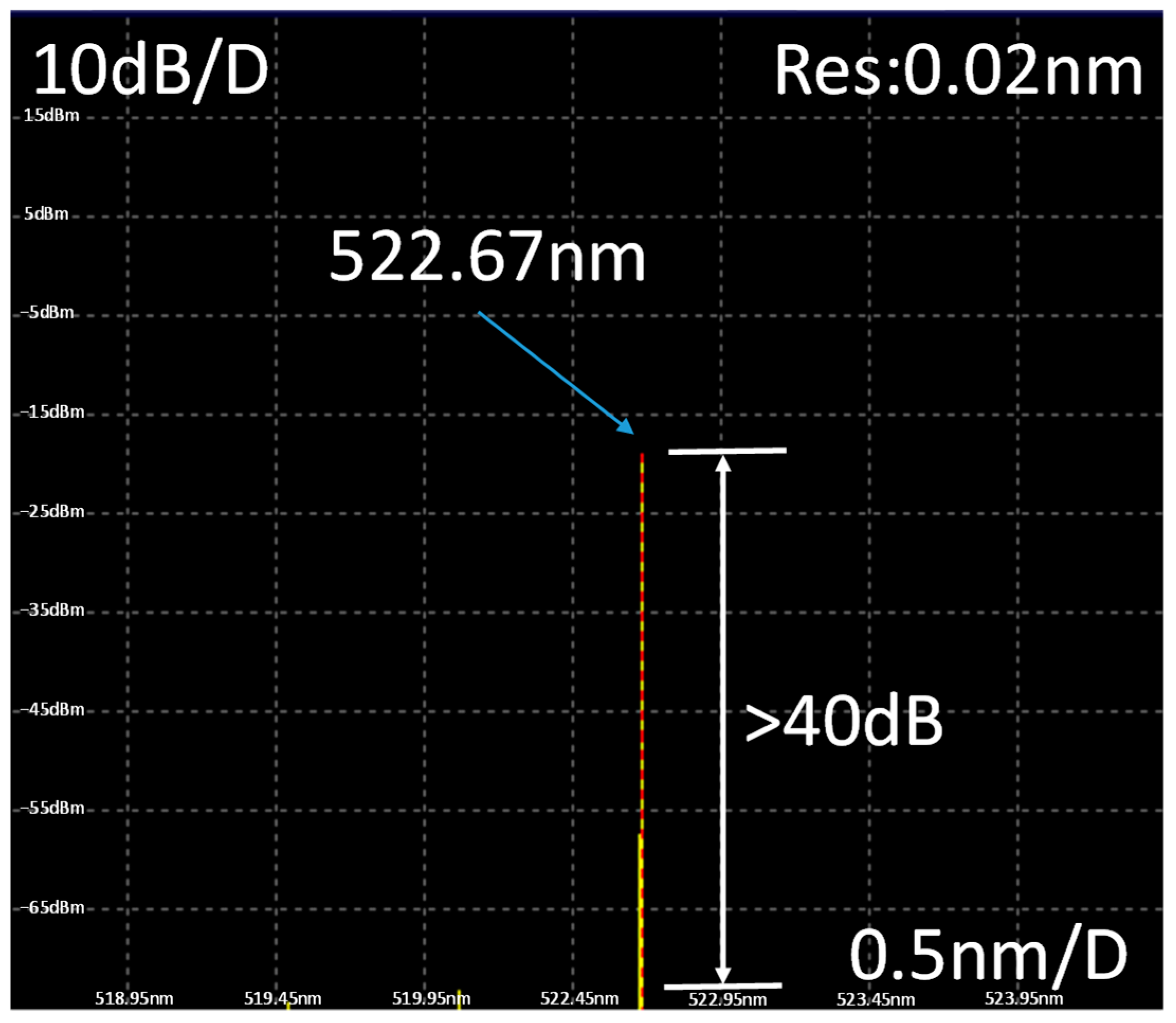
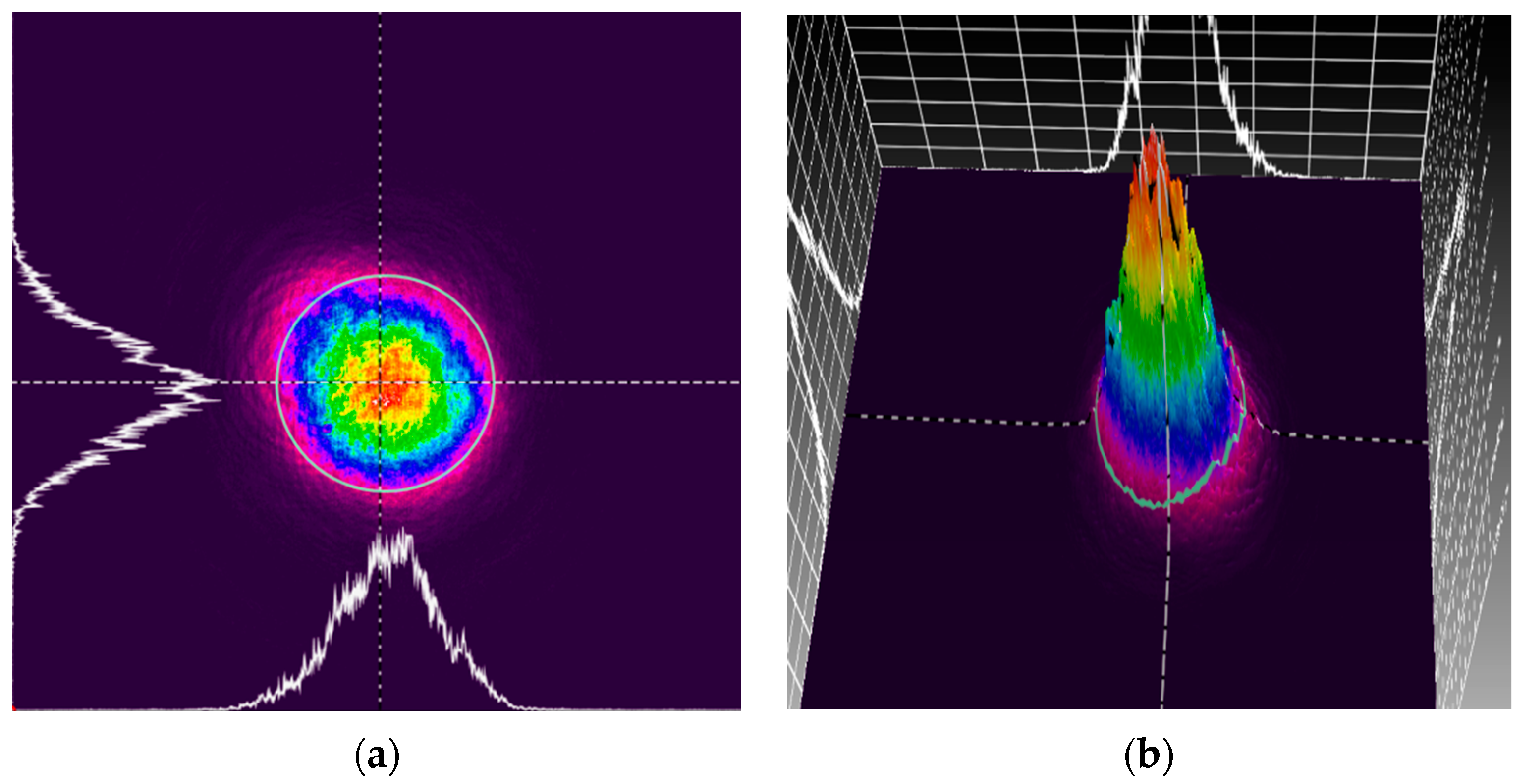
Disclaimer/Publisher’s Note: The statements, opinions and data contained in all publications are solely those of the individual author(s) and contributor(s) and not of MDPI and/or the editor(s). MDPI and/or the editor(s) disclaim responsibility for any injury to people or property resulting from any ideas, methods, instructions or products referred to in the content. |
© 2023 by the authors. Licensee MDPI, Basel, Switzerland. This article is an open access article distributed under the terms and conditions of the Creative Commons Attribution (CC BY) license (https://creativecommons.org/licenses/by/4.0/).
Share and Cite
Dai, W.; Wang, H.; Jin, L.; Liu, C.; Dong, Y.; Jin, G. Diode-Pumped Single-Longitudinal-Mode Pr3+:YLF Laser Based on Combined Fabry–Perot Etalons at 522.67 nm. Photonics 2023, 10, 971. https://doi.org/10.3390/photonics10090971
Dai W, Wang H, Jin L, Liu C, Dong Y, Jin G. Diode-Pumped Single-Longitudinal-Mode Pr3+:YLF Laser Based on Combined Fabry–Perot Etalons at 522.67 nm. Photonics. 2023; 10(9):971. https://doi.org/10.3390/photonics10090971
Chicago/Turabian StyleDai, Weicheng, Haozhu Wang, Long Jin, Chang Liu, Yuan Dong, and Guangyong Jin. 2023. "Diode-Pumped Single-Longitudinal-Mode Pr3+:YLF Laser Based on Combined Fabry–Perot Etalons at 522.67 nm" Photonics 10, no. 9: 971. https://doi.org/10.3390/photonics10090971
APA StyleDai, W., Wang, H., Jin, L., Liu, C., Dong, Y., & Jin, G. (2023). Diode-Pumped Single-Longitudinal-Mode Pr3+:YLF Laser Based on Combined Fabry–Perot Etalons at 522.67 nm. Photonics, 10(9), 971. https://doi.org/10.3390/photonics10090971



